Runner’s Footstrike – Does it matter?
Mark Green
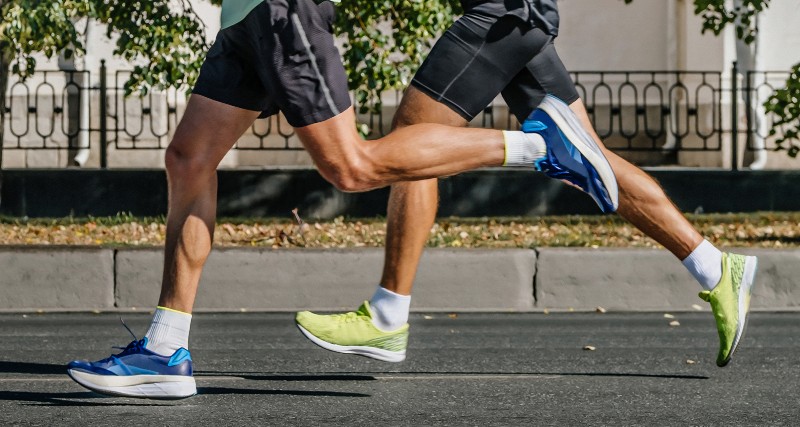
I’m sure most of you will be familiar with the term “footstrike”, and I imagine a lot of you have probably been told at some point that “you shouldn’t land on your heel” or “you should land on your forefoot”
Before I explain more about the different types of footstrike, let’s make something clear.
It doesn’t matter how your foot hits the ground.
One isn’t necessarily better or worse than another. In fact, the way that your foot strikes the ground might change several times during a run depending on the terrain you are running on, the speed you are running and how fatigued you are.
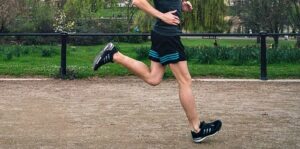 Heel Strike
Heel Strike
As the name suggests, with this style of running your heel hits the ground first, and then your weight rolls forward onto the rest of your foot. This is probably the most common type of footstrike that we see, and it is common for two main reasons.
- If you spend most of your day sitting down, you are likely to develop chronically tight hips, and lazy glute muscles. This causes your stride to land out in front of you, and when your foot lands in front of you, it is more natural for it to land heel first.
- Wearing cushioned shoes allows you to land on your heel and it doesn’t hurt. If you were to run in barefeet on a hard surface, it would hurt to land on your heel, so you would tend to default to landing further forward on your foot to reduce the pain.
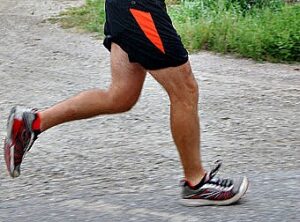
Midfoot Strike
This is where most of your foot hits the ground at the same time. You might have slightly more weight towards the front of your foot when you land, but almost instantaneously, the rest of your foot (including your heel) also contacts the ground.
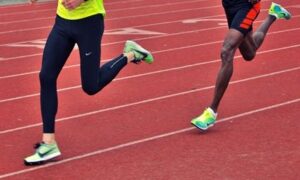 Forefoot Strike
Forefoot Strike
A forefoot strike is where your weight is concentrated on the ball of your foot and your toes when you land. Quite often with a forefoot strike your heel will never make contact with the ground. It is common for forefoot runners to land on the outer border of their foot.
How do you find out which type of footstrike you have?
The easiest way to identify your predominant foot striking pattern is to look at the sole of a pair of shoes you have run a few hundred km’s in. They need to be shoes used exclusively for running. If you also use them for walking, they will not paint an accurate picture, as walking gait is quite different than a running gait.
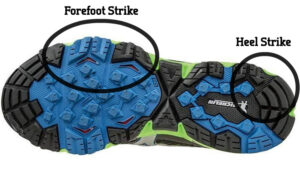 If the wear is mostly on the outside of the heel of the shoe, then you are predominantly a heel striker
If the wear is mostly on the outside of the heel of the shoe, then you are predominantly a heel striker- If the wear is quite evenly spread over the shoe and there isn’t an obvious spot which is more worn than the rest, then you are predominantly a midfoot striker
- If most of the wear is on the outside of the forefoot, then you are a forefoot striker
If footstrike doesn’t matter, what does?
The way that your foot strikes the ground does not matter, but where it contacts the ground in relation to your body weight does matter. The further in front of your body your foot lands, the more impact it causes, and the more it acts like a brake. To improve your running technique and help minimise the risk of causing an injury, your foot should strike the ground close to under your body.
This means a heelstrike under your body is preferable to a forefoot or midfoot strike in front of your body.
Watch this video which describes and demonstrates exactly what I mean by “infront of your body” and “under your body”
Should you try to control your footstrike?
No.
Trying to force your foot to land on the midfoot or forefoot creates tension in your foot. Your brain has to engage muscles to point the front of your foot downwards which causes your foot to stiffen. If you land on a stiff, semi-rigid foot, you have less of your natural shock absorption, which makes your more prone to injuries such as stress fractured metatarsals, calf strains and achilles tendonitis.
What if your footstrike changes when you run?
It is natural for your footstrike to change, and is not something you should focus on, or worry about. A natural footstrike is influenced by a multitude of factors including:
- The terrain you are running on (uphill / downhill / flat)
- The shoes you are wearing
- How fatigued your legs are (people tend to revert to heel striking when their calf muscles are fatigued)
- The speed you are running (have you ever tried sprinting with a heel strike?)
If you are running up a steep slope, it is natural to land more on the ball of your foot. This is because there is no ground under your heel so it has nowhere to land. If you are running down a steep slope most people will heel strike to help slow them down and control their speed. If you are sprinting towards the finish line you will naturally land up on the ball of your foot as this will help to give you the power to accelerate. If you are running in barefeet on a hard surface you will probably midfoot strike as it is much more comfortable to land on the softer fleshy part of your foot when you have no shoes on.
Footstrike tends to change with stride length
You might find that your foot strike changes if you work on improving your running technique by:
- Standing up tall
- Taking short steps
- Increasing your cadence
This is fine, as long as it happens naturally, rather than you trying to control it. If you have traditionally been an overstrider, then you are also most likely a heel striker. As you work on improving your running technique to a point where your foot lands closer to underneath you, then there is a good chance that your foot will land a bit flatter, possibly on the midfoot, but possibly still glancing the ground with the heel first.